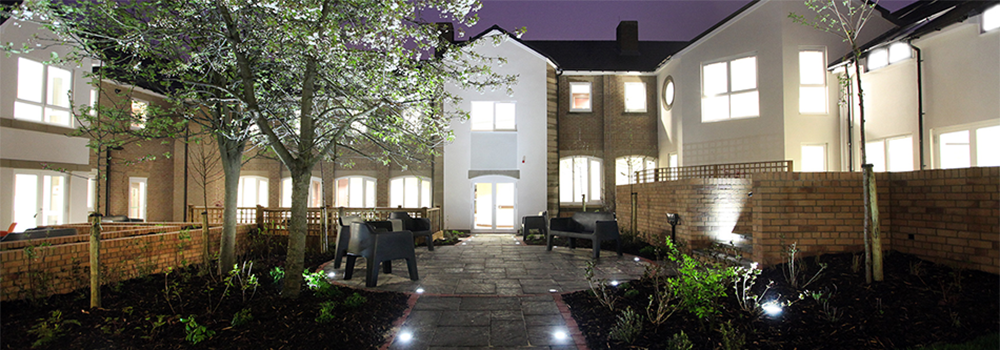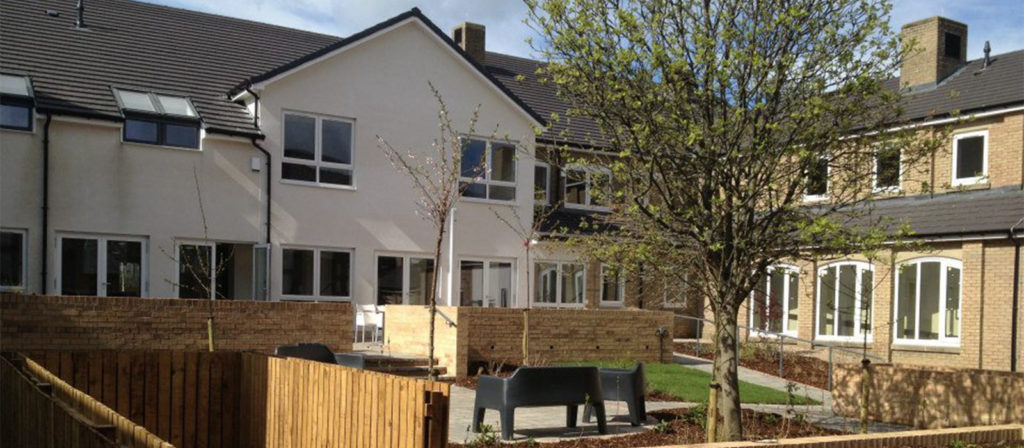
| CLIENT | UNIT BREAKDOWN | ROLE | DATES | VALUE |
|---|---|---|---|---|
| Derwentside Homes Ltd | 41 one & two-bedroom apartments | Project Manager | Start: March 2012 Completion: May 2013 | £3.71m |
Overview
Castle Court is a state-of-the-art, independent living scheme for the over 55s. The development brought together three buildings – all undergoing major modernisation and renovation and combined to create one stunning new development.
The finished scheme consists of 41 luxury one and two- bedroom apartments, all featuring fully fitted bathrooms and kitchens, an upgraded communal washing/drying area, modern wet rooms, a hairdresser’s room and an IT/cinema suite. One of the development’s most attractive features is a large, fully landscaped central courtyard.
Background
Castle Court first opened its doors in 1985 and comprised of 32 bedsits for older people. The property was separated into three distinct independent buildings with two of those units specifically designed to cater for the NHS. The former Durham County Council-owned residential home Manor House and Primary Care Trust office building Priory Court were combined with the original Castle Court building.
Derwentside Homes was responsible for the management and operation of Castle Court on behalf of the local authority. Due to the restructuring of local services, the NHS decided to decommission their services. This, coupled with the decline in demand for the type of housing offered by Castle Court, the local authority were then faced with an asset, which required extensive remodelling to attract new tenants and consequently opted to dispose of the site.
Our Approach
Elvet Construction Consultants acted as the Strategic Project Manager for Derwentside Homes to oversee their HCA Affordable Homes programme.
The Local Authority offered Derwentside Homes all three assets to convert into accommodation for older residence. At the beginning of the project, our role was to assess the financial performance of the asset looking at what options were available, for example:
- Retaining existing layout undertaking general improvements in accordance with Decent Home Standards;
- Remodelling and modernisation of the accommodation for older residence;
- Remodelling and modernisation for general residential;
- Demolition and redeveloping the site with new modern housing.
The initial financial appraisal considered the above scenarios taking into account the following key information to assess the sustainability of the proposals over a 30-year life cycle:
- Revenue – rents, affordable rents, service charges
- Management costs
- Capital investment
- Demand
- Voids
- Repairs and maintenance (responsive and planned) Our role throughout the whole project included:
- Financial appraisals / cost plans / feasibility studies;
- Procurement process – advising on the most appropriate route, co-ordination and management of tender documents, tender evaluation and preparing the contract documents;
- HCA compliance – ensuring that the scheme was delivered in accordance with the HCA contract to maximise the allocated funding for the project;
- Financial control – ensuring the scheme offered value for money, within the client’s budget. Agreement of interim valuations, variations and the final account;
- Project Management – monitoring the programme, liaising with the contractor to ensure key milestones were achieved. Reporting progress to the client;
- Contract Management – liaising with the project delivery team to ensure that the client’s requirements were delivered.

Outcome
The development, which was successfully awarded the RICS North East Renaissance Awards Residential Development of the Year 2014, has brought together three obsolete buildings, all undergoing major modernisation and renovation and combined to create one stunning new development.
Castle Court demonstrates that a high quality sustainable scheme can be secured through a value driven approach. The scheme achieves a significant step change in previous objectives and raises the bar in delivering desired outcomes through an innovative approach to procurement. It combines a value for money approach with aspirational design using the combined expertise of the team.
This scheme sets new standards for accommodation for the over 55s. Customers were at the forefront with tenant-led consultation undertaken to establish their aspirations, which identified the need for providing a modern development, which not only catered for the pace to live now but providing a long term home that can meet changing needs.
The three existing buildings were obsolete and unsustainable. Castle Court now delivers homes where people aspire to live. The scheme has been remodelled and refurbished to achieve Lifetime Homes and SDS standards wherever possible within the existing building constraints.
At times, it is too easy to give up on existing buildings and pursue a demolition and new build route. A more holistic assessment of the options available can lead to innovation, creativity and a project that can offer fantastic results for future tenants and the local community. Castle Court is a great example of this approach.
Some of the benefits created were:
- It was quicker and cheaper to deliver a conversion than a new build project
- It enabled tenants to move into their homes quicker
- It provided quicker positive community impact and a new landmark feature to the high street
- It received Homes and Community Agency Funding with many areas exceeding set standards
- The conversion enabled Derwentside Homes to let homes more quickly, benefitting those on the waiting list
- Derwentside Homes received income from Castle Court quicker than a new build making it a more viable financial arrangement
- There was a quicker community benefit as local shops benefitted from increased trade more quickly
A holistic procurement process was undertaken, embracing all aspects of design requirements, meeting customer needs and internal specification. This innovative approach provided clear parameters of outcomes but offered flexibility and creativity in approach.
The key to the process was that bidders had to understand the client’s vision quickly and engage with its supply chain directly early on in the process. Due to the complex nature of the refurbishment, detailed input was needed by M&E consultants and Structural Engineer partners to support design work which then evolved into detailed design and internal design and decoration. This approach created a true team effort from the outset, ensuring that innovation, costs management, physical constraints and community and client outcomes were delivered.
 Award-winning Chartered Quantity Surveyors and RICS Chartered Building Surveyors. T: +44 (0) 191 7166768
Award-winning Chartered Quantity Surveyors and RICS Chartered Building Surveyors. T: +44 (0) 191 7166768 